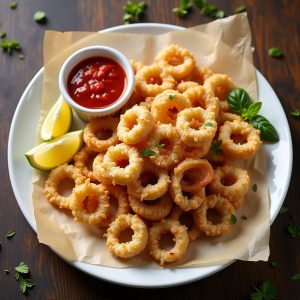
AI generated image
Chef's Tip
For the most tender calamari, don't skip the 15-minute buttermilk soak, which helps tenderize the squid. And remember that calamari cooks extremely quickly - it only needs 2-3 minutes in hot oil. Any longer and it will become tough and rubbery.
Instructions
- Place cleaned calamari in a bowl with buttermilk and let soak for 15 minutes to tenderize.
- Meanwhile, in a large bowl, whisk together all-purpose flour, semolina flour, cornstarch, baking powder, salt, black pepper, cayenne pepper, and garlic powder.
- Heat oil in a large, heavy-bottomed pot or deep fryer to 350°F.
- While oil heats, prepare the marinara: In a small saucepan, combine marinara sauce, minced garlic, and red pepper flakes (if using). Warm over low heat for 5 minutes, then stir in 1 tablespoon of chopped basil. Keep warm.
- Working in batches, remove calamari from buttermilk, allowing excess to drip off, then dredge in the flour mixture, shaking off excess.
- Carefully lower coated calamari into hot oil and fry until golden and crispy, about 2-3 minutes. Don't overcrowd the pot.
- Using a slotted spoon or spider strainer, transfer fried calamari to a paper towel-lined plate. Season immediately with a light sprinkle of salt.
- Continue with remaining calamari, making sure oil temperature returns to 350°F between batches.
Plating
Arrange the fried calamari on a serving platter lined with a paper doily or parchment paper. Sprinkle with remaining fresh basil and serve immediately with the warm marinara sauce in a small bowl for dipping. Include lemon wedges on the side for squeezing over the calamari just before eating, which brightens the flavor and adds a fresh accent.
Storage & Reheating
Fried calamari is best consumed immediately after cooking. Leftovers can be stored in an airtight container in the refrigerator for up to 1 day but will lose their crispness. Reheat in a 375°F oven for 5-7 minutes. Marinara sauce can be refrigerated separately for up to 5 days.
About This Recipe
While calamari has Italian origins, it became a staple on New England menus as Portuguese and Italian fishing communities established themselves along the coast. This recipe draws on the region's tradition of simply prepared, ultra-fresh seafood while incorporating the light, crispy coating perfected in local restaurants. The accompanying marinara nods to the Italian influence on New England's coastal cuisine.
